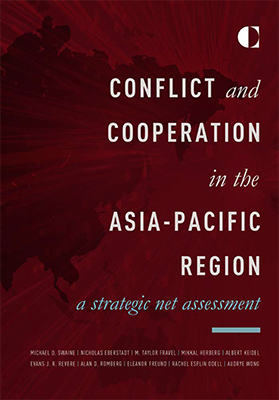The Asia-Pacific region is undergoing enormous change, fueled by high levels of economic growth and deepening levels of integration. These and other forces are generating a shift in the distribution of economic, political, and military power across the region. This changing security environment poses a major challenge for the United States, the historically dominant power in maritime Asia. Efforts to enhance regional cooperation, reassure allies, and deter and shape potentially destabilizing behavior are demanding a more complex mixture of U.S. skills and understanding. An array of current and likely long-term forces will drive both cooperation and conflict across the Asia-Pacific region.
Key Findings
There are five different security environments that could emerge in the Asia-Pacific region over the next twenty-five years (in order of likelihood):
- Status Quo Redux: Constrained economic and political competition alongside continuing cooperation
- Asia-Pacific Cold War: Deepening regional bipolarization and militarization, driven by a worsening U.S.-China strategic and economic rivalry
- Pacific Asia-Pacific: Reduced tension and increased U.S.-China and regional cooperation
- Asian Hot Wars: Episodic but fairly frequent military conflict in critical hot spots, emerging against a cold war backdrop
- Challenged Region: A region beset by social, economic, and political instability and unrest separate from U.S.-China competition
Risks in the Evolving Security Environment
- The primary risk: movement toward the conflictual side of the Status Quo Redux security environment due to an uncertain pattern of economic, political, and military multipolarity and a divergence in opinion concerning the proper distribution of power
- A shift in resources toward security competition
- Increased tests of resolve and political-military crises
- A United States embroiled in third-party disputes
- Greater challenges to the U.S. alliance system
- Exclusionary political and economic arrangements
- Domestic instability and regime collapse in North Korea
- Domestic instability and ultranationalism in China
- U.S. miscalculations in response to a more assertive China
Factors That Could Restrain or Eliminate Risks
- Common support for sustaining economic growth
- The absence of existential disputes
- Enduring U.S. strength
- The possibility of a more flexible China
- Cooperation in dealing with North Korea
- Collaboration in addressing transnational threats
Steps the United States Can Take to Avert Conflict
Identify U.S. interests in the Asia-Pacific. U.S. agencies should identify the United States’ longterm primary, secondary, and tertiary strategic interests in the Asia-Pacific.
Conduct an unprecedented U.S.-China strategic dialogue. An ongoing, government-supported but unofficial track 2 effort could eventually feed into a more formal track 1.5 dialogue in the military and diplomatic realms.
Undertake a range of strategic assurances between the United States and China. A variety of specific reciprocal and joint actions should be considered as near- to medium-term initiatives to provide greater strategic reassurance between Washington and Beijing.
Clarify and strengthen the U.S. position on maritime disputes. In the South China Sea, Washington should encourage all sides to lower the perceived value of the disputed islands by delineating joint fishing, hydrocarbon, seabed minerals, and environmental protection zones. The United States should also encourage the disputants to enhance crisis management.
Coordinate a force for sea lines of communication (SLOC) defense. Washington should undertake a sustained effort to establish a joint maritime force involving the United States, China, and other Asian states in SLOC defense.
Provide greater support for crisis management mechanisms. These mechanisms could help avert or manage future political-military crises over maritime territorial disputes and other contentious issues.
Establish a forum for the discussion of energy security issues. Such a forum would be a vital channel for addressing tensions over the control of energy resources and transportation routes in the region.
Strengthen engagement with the Association of Southeast Asian Nations (ASEAN) and with individual member states. The United States should promote a U.S.-ASEAN free trade agreement and strengthen ASEAN institutions by endorsing their role as action-oriented bodies that are able to tackle regional issues.





